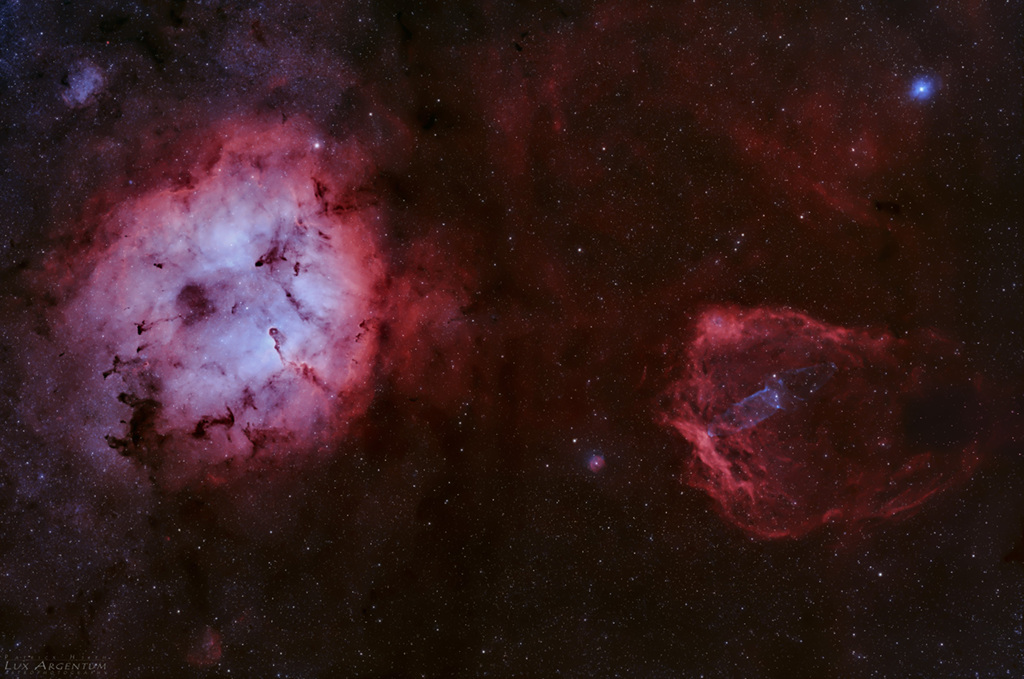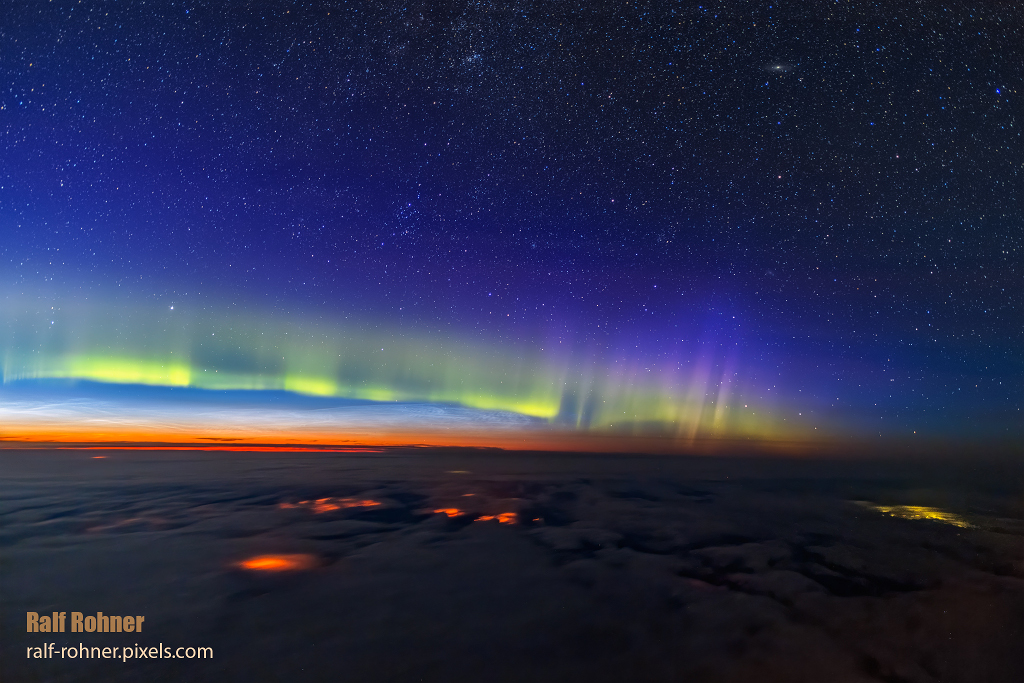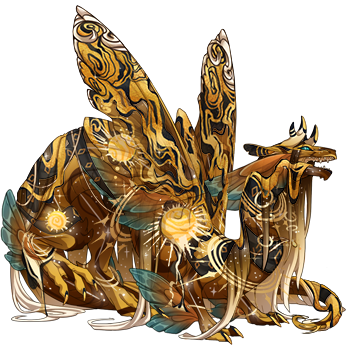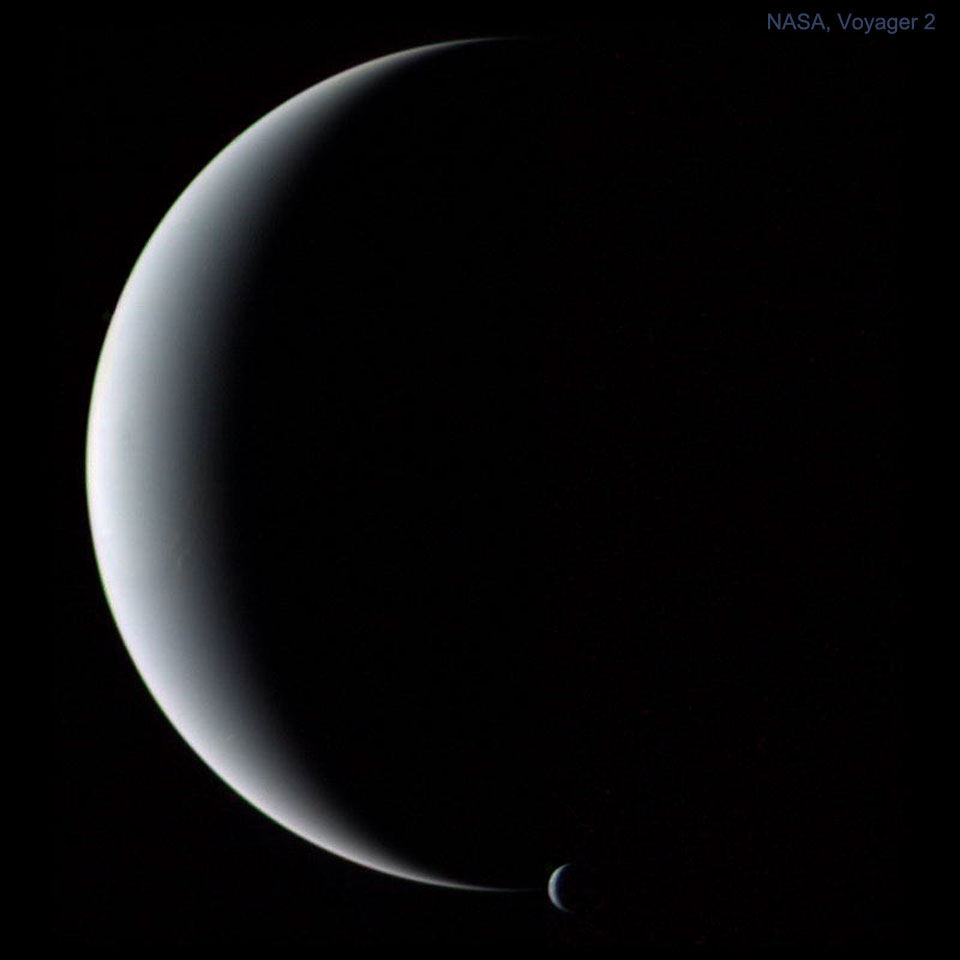Wednesday's [url=https://apod.nasa.gov/apod/astropix.html]daily astronomy picture[/url] is fitting for the Lightning Flight, referencing the Norse god of thunder!
[center][img]https://apod.nasa.gov/apod/image/2107/ThorsHelmet_Miller_960.jpg[/img]
[b]Thor's Helmet[/b]
[b]Image Credit & Copyright:[/b] Bernard Miller
[b]Explanation:[/b] Thor not only has his own day (Thursday), but a helmet in the heavens. Popularly called Thor's Helmet, NGC 2359 is a hat-shaped cosmic cloud with wing-like appendages. Heroically sized even for a Norse god, Thor's Helmet is about 30 light-years across. In fact, the cosmic head-covering is more like an interstellar bubble, blown with a fast wind from the bright, massive star near the bubble's center. Known as a Wolf-Rayet star, the central star is an extremely hot giant thought to be in a brief, pre-supernova stage of evolution. NGC 2359 is located about 15,000 light-years away toward the constellation of the Great Overdog. This remarkably sharp image is a mixed cocktail of data from broadband and narrowband filters, capturing not only natural looking stars but details of the nebula's filamentary structures. The star in the center of Thor's Helmet is expected to explode in a spectacular supernova sometime within the next few thousand years.
Wednesday's
daily astronomy picture is fitting for the Lightning Flight, referencing the Norse god of thunder!
 Thor's Helmet
Image Credit & Copyright:
Thor's Helmet
Image Credit & Copyright: Bernard Miller
Explanation: Thor not only has his own day (Thursday), but a helmet in the heavens. Popularly called Thor's Helmet, NGC 2359 is a hat-shaped cosmic cloud with wing-like appendages. Heroically sized even for a Norse god, Thor's Helmet is about 30 light-years across. In fact, the cosmic head-covering is more like an interstellar bubble, blown with a fast wind from the bright, massive star near the bubble's center. Known as a Wolf-Rayet star, the central star is an extremely hot giant thought to be in a brief, pre-supernova stage of evolution. NGC 2359 is located about 15,000 light-years away toward the constellation of the Great Overdog. This remarkably sharp image is a mixed cocktail of data from broadband and narrowband filters, capturing not only natural looking stars but details of the nebula's filamentary structures. The star in the center of Thor's Helmet is expected to explode in a spectacular supernova sometime within the next few thousand years.
It's Thursday, which means it's time for another [url=https://apod.nasa.gov/apod/astropix.html]Astronomy picture of the day[/url]! This one requires a little more explanation than the others!
[center][img]https://apod.nasa.gov/apod/image/2107/RingColorsOH_Vanderbei_1080.jpg[/img]
[b]Colors: Ring Nebula versus Stars[/b]
[b]Image Credit:[/b] Robert Vanderbei (Princeton U.)
[b]Explanation:[/b] What if you could see, separately, all the colors of the Ring? And of the surrounding stars? There's technology for that. The featured image shows the Ring Nebula (M57) and nearby stars through such technology: in this case, a prism-like diffraction grating. The Ring Nebula is seen only a few times because it emits light, primarily, in only a few colors. The two brightest emitted colors are hydrogen (red) and oxygen (blue), appearing as nearly overlapping images to the left of the image center. The image just to the right of center is the color-combined icon normally seen. Stars, on the other hand, emit most of their light in colors all across the visible spectrum. These colors, combined, make a nearly continuous streak -- which is why stars appear accompanied by multicolored bars. Breaking object light up into colors is scientifically useful because it can reveal the elements that compose that object, how fast that object is moving, and how distant that object is.
It's Thursday, which means it's time for another
Astronomy picture of the day! This one requires a little more explanation than the others!
 Colors: Ring Nebula versus Stars
Image Credit:
Colors: Ring Nebula versus Stars
Image Credit: Robert Vanderbei (Princeton U.)
Explanation: What if you could see, separately, all the colors of the Ring? And of the surrounding stars? There's technology for that. The featured image shows the Ring Nebula (M57) and nearby stars through such technology: in this case, a prism-like diffraction grating. The Ring Nebula is seen only a few times because it emits light, primarily, in only a few colors. The two brightest emitted colors are hydrogen (red) and oxygen (blue), appearing as nearly overlapping images to the left of the image center. The image just to the right of center is the color-combined icon normally seen. Stars, on the other hand, emit most of their light in colors all across the visible spectrum. These colors, combined, make a nearly continuous streak -- which is why stars appear accompanied by multicolored bars. Breaking object light up into colors is scientifically useful because it can reveal the elements that compose that object, how fast that object is moving, and how distant that object is.
Today's [url=https://apod.nasa.gov/apod/astropix.html]Astronomy Picture of the Day[/url] is truly stunning.
[center][img]https://apod.nasa.gov/apod/image/2107/NGC7814withSN2021rhuChart32_1024.jpg[/img]
[b]NGC 7814: Little Sombrero with Supernova[/b]
[b]Image Credit & Copyright:[/b] CHART32 Team
[b]Explanation:[/b] Point your telescope toward the high flying constellation Pegasus and you can find this expanse of Milky Way stars and distant galaxies. NGC 7814 is centered in the pretty field of view that would almost be covered by a full moon. NGC 7814 is sometimes called the Little Sombrero for its resemblance to the brighter more famous M104, the Sombrero Galaxy. Both Sombrero and Little Sombrero are spiral galaxies seen edge-on, and both have extensive halos and central bulges cut by a thin disk with thinner dust lanes in silhouette. In fact, NGC 7814 is some 40 million light-years away and an estimated 60,000 light-years across. That actually makes the Little Sombrero about the same physical size as its better known namesake, appearing smaller and fainter only because it is farther away. In this telescopic view from July 17, NGC 7814 is hosting a newly discovered supernova, dominant immediately to the left of the galaxy's core. Cataloged as SN 2021rhu, the stellar explosion has been identified as a Type Ia supernova, useful toward calibrating the distance scale of the universe.
Today's
Astronomy Picture of the Day is truly stunning.
 NGC 7814: Little Sombrero with Supernova
Image Credit & Copyright:
NGC 7814: Little Sombrero with Supernova
Image Credit & Copyright: CHART32 Team
Explanation: Point your telescope toward the high flying constellation Pegasus and you can find this expanse of Milky Way stars and distant galaxies. NGC 7814 is centered in the pretty field of view that would almost be covered by a full moon. NGC 7814 is sometimes called the Little Sombrero for its resemblance to the brighter more famous M104, the Sombrero Galaxy. Both Sombrero and Little Sombrero are spiral galaxies seen edge-on, and both have extensive halos and central bulges cut by a thin disk with thinner dust lanes in silhouette. In fact, NGC 7814 is some 40 million light-years away and an estimated 60,000 light-years across. That actually makes the Little Sombrero about the same physical size as its better known namesake, appearing smaller and fainter only because it is farther away. In this telescopic view from July 17, NGC 7814 is hosting a newly discovered supernova, dominant immediately to the left of the galaxy's core. Cataloged as SN 2021rhu, the stellar explosion has been identified as a Type Ia supernova, useful toward calibrating the distance scale of the universe.
It's Friday, woohoo! Time to celebrate with another [url=https://apod.nasa.gov/apod/astropix.html]Astronomy Picture of the Day[/url]!
[center][img]https://apod.nasa.gov/apod/image/2107/IC1396SH2-129Ou4_50Hsieh_1024.jpg[/img]
[b]Elephant, Bat, and Squid[/b]
[b]Image Credit & Copyright:[/b] Patrick Hsieh
[b]Explanation:[/b] Sprawling emission nebulae IC 1396 and Sh2-129 mix glowing interstellar gas and dark dust clouds in this 10 degree wide field of view toward the northern constellation Cepheus the King. Energized by its bluish central star IC 1396 (left) is hundreds of light-years across and some 3,000 light-years distant. The nebula's intriguing dark shapes include a winding dark cloud popularly known as the Elephant's Trunk below and right of center. Tens of light-years long, it holds the raw raw material for star formation and is known to hide protostars within. Located a similar distance from planet Earth, the bright knots and swept back ridges of emission of Sh2-129 on the right suggest its popular name, the Flying Bat Nebula. Within the Flying Bat, the most recently recognized addition to this royal cosmic zoo is the faint bluish emission from Ou4, the Giant Squid nebula.
It's Friday, woohoo! Time to celebrate with another
Astronomy Picture of the Day!
 Elephant, Bat, and Squid
Image Credit & Copyright:
Elephant, Bat, and Squid
Image Credit & Copyright: Patrick Hsieh
Explanation: Sprawling emission nebulae IC 1396 and Sh2-129 mix glowing interstellar gas and dark dust clouds in this 10 degree wide field of view toward the northern constellation Cepheus the King. Energized by its bluish central star IC 1396 (left) is hundreds of light-years across and some 3,000 light-years distant. The nebula's intriguing dark shapes include a winding dark cloud popularly known as the Elephant's Trunk below and right of center. Tens of light-years long, it holds the raw raw material for star formation and is known to hide protostars within. Located a similar distance from planet Earth, the bright knots and swept back ridges of emission of Sh2-129 on the right suggest its popular name, the Flying Bat Nebula. Within the Flying Bat, the most recently recognized addition to this royal cosmic zoo is the faint bluish emission from Ou4, the Giant Squid nebula.
It's time for today's [url=https://apod.nasa.gov/apod/astropix.html]Astronomy Picture of the Day[/url]!
[center][img]https://apod.nasa.gov/apod/image/2107/AuroraNoctilucent33k_rohner1024.jpg[/img]
[b]The Edge of Space
Image Credit & Copyright:[/b] Ralf Rohner
[b]Explanation:[/b] Where does space begin? For purposes of spaceflight some would say at the Karman line, currently defined as an altitude of 100 kilometers (60 miles). Others might place a line 80 kilometers (50 miles) above Earth's mean sea level. But there is no sharp physical boundary that marks the end of atmosphere and the beginning of space. In fact, the Karman line itself is near the transition between the upper mesophere and lower thermosphere. Night shining or noctilucent clouds are high-latitude summer apparitions formed at altitudes near the top of the mesophere, up to 80 kilometers or so, also known as polar mesopheric clouds. Auroral bands of the northern (and southern) lights caused by energetic particles exciting atoms in the thermosphere can extend above 80 kilometers to over 600 kilometers altitude. Taken from a cockpit while flying at an altitude of 10 kilometers (33,000 feet) in the realm of stratospheric aeronautics, this snapshot captures both noctilucent clouds and aurora borealis under a starry sky, looking toward planet Earth's horizon and the edge of space.
It's time for today's
Astronomy Picture of the Day!
 The Edge of Space
The Edge of Space
Image Credit & Copyright: Ralf Rohner
Explanation: Where does space begin? For purposes of spaceflight some would say at the Karman line, currently defined as an altitude of 100 kilometers (60 miles). Others might place a line 80 kilometers (50 miles) above Earth's mean sea level. But there is no sharp physical boundary that marks the end of atmosphere and the beginning of space. In fact, the Karman line itself is near the transition between the upper mesophere and lower thermosphere. Night shining or noctilucent clouds are high-latitude summer apparitions formed at altitudes near the top of the mesophere, up to 80 kilometers or so, also known as polar mesopheric clouds. Auroral bands of the northern (and southern) lights caused by energetic particles exciting atoms in the thermosphere can extend above 80 kilometers to over 600 kilometers altitude. Taken from a cockpit while flying at an altitude of 10 kilometers (33,000 feet) in the realm of stratospheric aeronautics, this snapshot captures both noctilucent clouds and aurora borealis under a starry sky, looking toward planet Earth's horizon and the edge of space.
[center]A quick heads up too, today is the last day you can visit our [url=https://www1.flightrising.com/forums/raf/3038211/1#post_48394909]Out Of Flight Raffle and collect those limited Daily Badges![/url] If you collect all 7 from the OOFR and [url=https://www1.flightrising.com/forums/frd/3038345/1#post_48399065]all 5 from our other events[/url], you'll earn a special completion badge (to be revealed during TCC)!
[img]https://i.imgur.com/oprG45b.gif[/img]
Hello sparks, and thank you all for a fantastic push week! Enjoy this year's TCC, get that currency, and check out part two of our Fallen Stars Event!
[center][size=7][color=3c946b][b]Fallen Stars[/b][/color][/size]
July 26 - 31
Open to everyone
[url=https://www1.flightrising.com/forums/qnc/3040673#post_3040673][img]https://www1.flightrising.com/rendern/350/682089/68208811_350.png[/img][/url][/center]
Fallen stars litter the desert, leaving behind fascinating remnants. Starxia is looking to get her claws on as many pieces of fallen star that she can and is willing to offer fancy badges and prizes for those who assist her!
She is in desperate need of assistance with her goal! [b]She will give you tickets in exchange for currency and items.[/b]
Each day you send something in you can earn a new badge.
[quote name="Prizes"][center]
[item=Lightning Sprite][item=Electricians Power Pack][item=Eliminate][item=Unhatched Light Egg]
[quote=Starxia]
[url=https://www1.flightrising.com/dragon/68208811][img]https://www1.flightrising.com/rendern/350/682089/68208811_350.png[/img][/url]
Level 25. Bronze Starmap, Bronze Constellation, Bronze Diaphanous.
Comes with [item=scroll of renaming][item=ambush] x2 [item=berserker] x3 [item=eliminate]
[/quote]
[url=https://www1.flightrising.com/forums/qnc/3040673#post_3040673]Visit the thread here![/url]
[size=0][size=0]Join the dominance pinglists here. This is the main pinglist! @@shinxscientist @abs0lute @accabear @accelerator @achromaticspark @acretosorien @actaeon @aeronaught @aetherskyes @ailir @alexza @altidx @ambitious @ancientsecrets @androbot @anitaku @anovaal @apetras @aquilaaltair @argente @aroc5x @arsenicfawn @attolia @avariea @avatasho @bardstale @bibliotaphcat @biologiquill @birdhouse @bluelightning @bluesparrow46 @bottledlightning @bozanstvena @bravehearted @breathe2 @brecheese @brinbellway @bugsbenedict @bzoozu @caecus @car340 @casanoble @ceruleancrow @cheetospotato @chenxin @chrysanthos @cinnacreme @clerval @coalchaser @coiote @comic1sans @comicsans @confusedpaladin @corehope @cosmiclattecat @cosmochuck @countingchocobos @cowboymouth @coyoterodeo @crisdaro @crystal4180 @cybernexus @cyborb @cypris @dantella @darkrebellionxyz @dayglohyena @dayofdiana @deadlyinformant @deathstalker @deersoup @denryu @depravityinblack @desmordus @diamondbacked @dilsdoes @doveandgrenade @dragoneko @dramhammersong @drymm @dudodo @dussty @dweam @dysnomya @ebby172 @edenprimes @eflat @eindride @eleandra @electrifying @elerinwen @ern @faewingfury @fedog @feinics @felixegadrik @fieldraptor @flayn @flygone @foxhermit @fraudulentzodiac @freshpeachez @fusionboltzgx @garjansverd @geminisun @gilan @glaedrgoldscale @gloamingchild @graphicchibi @grech @gwogobo @haixin @hallowdarkfrost @helloca @hobokianbo @huhansan @icetones @idryu @ilan @imaginewagons420 @imarru @impossiblejedi4 @indigopi @interestingox @intermission @istalriblaka @itsyaboinyx @izzetqueen @jazzghost @jazzly @joule @julijohn99 @jupiteru @kairyudee @kalynaanne @kanitai @kapara @karikumik @kawaiichibikitty @keryth @keverdeenaj @kindly @kitiarawoodbane @kitkatmreow @kiwibutter16 @kodak @kontyre @korpinsiipi @koujakward @kururin @kyaniite @kywren @labcoat @labrynna @ladylightning @ladysteam @lagiacrusoe @lampii @lampnoodle @leafalie @lehlora @lgfuadjj @lightingstrikes @lightningbender @lightningbugs @lino @lordjeanliness @loviare @luftschlosseule @lumenwood @lunarglim @lyka @lynxsideris @macpac @mafiavamp @magicalaether @main pinglist @malachai @maliblu @maralaray @mdoatb @meggolor @melisont @memoralis @merrymercutio @mewten @mickthemouse @micool @mishil @mlpmdog @mondschatten @morgrim @mousemouse @mulpi @mydragonsfly @mystel @nabal @naga150 @narwhalsaurus @nekkochan @nekonikki @nelson @nerdesq @nerdofnerds @netherguard @neutron @niesse @nightlilac @nimitsu @nitch @nitsuj @no1chrispycat @norkia @nostalgicgalaxy @novalore @novarys @oatcrunch @okn @onetruerumor @ototo @oyasumikasumi @pandamoniaz @paperworkninja @pavus @pearidot913 @penantiomers @penguinboi @pepperhead @phoenixglory @poetic @poistel @predacon @premiumhugs @princepotatoes @pseudonimbus @pseudonum @psionicjackal @punchycat @purplelizard @pwnysparklez @qualia @quantum @queenfirefly @queerqueg @quens @quinntessence @quotesnmiracles @ragnal @rainwater @raptorflight @rattz @realitymask @recursionerr0r @reubjuniper @rexes @riooo @ripplezzz @riseandshine @riskyred @rivaxorus @rosecrimson @roudanluoja @rowanofrohan @rquestions @rubyroth @russetdown @ryasma @salem @sazerac @science @scmarshtacky @seaeagle @seim @serpentine72 @serpentstrike @seylon @shadowglen3000 @shanora @shar07 @shienvien @shinykari @shougoney @skeletalecho @skirtwizard @skydagger @skyfirehuntress @snowmewdraws @solys @sporkboi7 @starrunner101 @starryspelunker @stopboorider @stormchesters @stormdragon21 @stormpuppy @sturmflux @subliminalcircle @sukottoizanagi @supersmurb @sybretooth @syceris @tamarin21 @tanadin @tanujagtap @tearex @technicaldragon @teenytinydragon @terminaleternity @tesserwings @thebicycle @theemeraldstitch @thefatrabbit @thegamemother @theneonfox @thestudymage @thunderlycaon @tihe @tiite @titan @toastsong @tomswifty @tria @troupleking @truthseekersky6 @typedrat @underooz @vai @vakarians @valarauka @valikor @vbsupernova @vehlek @vendettas @victorycalls @virtualhel @visceryl @vistron @wannabeelf @warriorsgate @weyc @whitelightnin @windstrike @wintaer @wordstarter2010 @wwhirlybirb @xavmeep @xavvy @xuliana @yuumi @zatryx @zefyre @zerohour @zokorai @zopponde
Hello sparks, and thank you all for a fantastic push week! Enjoy this year's TCC, get that currency, and check out part two of our Fallen Stars Event!
Fallen Stars
July 26 - 31
Open to everyone

Fallen stars litter the desert, leaving behind fascinating remnants. Starxia is looking to get her claws on as many pieces of fallen star that she can and is willing to offer fancy badges and prizes for those who assist her!
She is in desperate need of assistance with her goal!
She will give you tickets in exchange for currency and items.
Each day you send something in you can earn a new badge.
Heads up! Today is the last day you can participate in the
Stargazing Egg Guess to earn the Gemini collectible badge! Collect all 12 from our OOFR and
events and you'll earn a special constellation badge at the end!
Heads up! Today is the last day you can participate in the
Stargazing Egg Guess to earn the Gemini collectible badge! Collect all 12 from our OOFR and
events and you'll earn a special constellation badge at the end!
It's the first day of TCC and time for an [url=https://apod.nasa.gov/apod/astropix.html]Astronomy Picture of the Day[/url]!
[center][img]https://apod.nasa.gov/apod/image/2107/neptunetriton_voyager_960.jpg[/img]
[b]Crescent Neptune and Triton
Image Credit:[/b] NASA, Voyager 2
[b]Explanation:[/b] Gliding silently through the outer Solar System, the Voyager 2 spacecraft camera captured Neptune and Triton together in crescent phase. The elegant picture of the ice-giant planet and its cloudy moon was taken from behind just after closest approach in 1989. It could not have been taken from Earth because Neptune never shows a crescent phase to sunward Earth. The unusual vantage point also robs Neptune of its familiar blue hue, as sunlight seen from here is scattered forward, and so is reddened like the setting Sun. Neptune is smaller but more massive than Uranus, has several dark rings, and emits more light than it receives from the Sun.
It's the first day of TCC and time for an
Astronomy Picture of the Day!
 Crescent Neptune and Triton
Crescent Neptune and Triton
Image Credit: NASA, Voyager 2
Explanation: Gliding silently through the outer Solar System, the Voyager 2 spacecraft camera captured Neptune and Triton together in crescent phase. The elegant picture of the ice-giant planet and its cloudy moon was taken from behind just after closest approach in 1989. It could not have been taken from Earth because Neptune never shows a crescent phase to sunward Earth. The unusual vantage point also robs Neptune of its familiar blue hue, as sunlight seen from here is scattered forward, and so is reddened like the setting Sun. Neptune is smaller but more massive than Uranus, has several dark rings, and emits more light than it receives from the Sun.

































